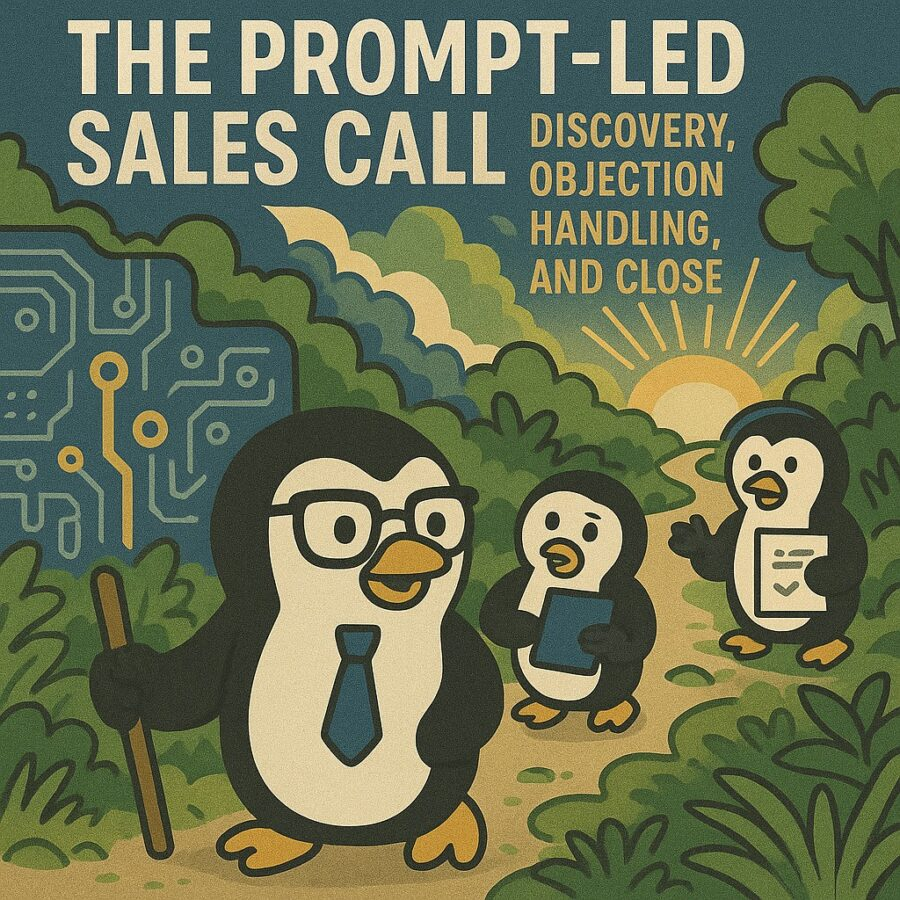Views: 1
High performers do not “wing it” on calls. They run structured conversations with smart prompts that uncover truth, reduce friction, and get to a clear next step. The Prompt-Led Sales Call: Discovery, Objection Handling, And Close is a clean system you can memorize and use this week. It blends proven research on discovery and negotiation with practical scripts you can paste into your workflow. You will learn what to ask, why to ask it, and how to steer the call without sounding pushy.
Modern data helps. Conversation intelligence studies show that winning reps tend to speak less than the average, and they balance talk and listen with intent. A recent analysis reports that closed-won calls cluster near a lower talk share than lost deals. That supports a discipline of questions first, pitch later. (Gong) Negotiation research also nudges us toward better questions. Harvard Business Review reports that open-ended questions correlate with stronger outcomes because they invite richer information and uncover interests behind positions. That is exactly what a good prompt does on a sales call. (Harvard Business Review)
This playbook maps those insights to a simple three-part call: Discovery, Objection Handling, and Close. Each part includes prompt blocks you can adapt on the fly. Keep the language plain. Keep sentences short. Keep the next step specific.
Call setup that reduces friction
Use a one-page prep sheet before every meeting. Capture three items. First, the problem statement you believe the prospect cares about. Second, the two outcomes that would count as success for them. Third, the two proof points you can show if asked. This sets the stage for a crisp conversation where your prompts guide rather than spray.
Target a steady talk-to-listen balance. You do not need a perfect ratio, but you should avoid monologues. Data from 2025 shows an average 60 to 40 split across calls, with closed-won deals skewing to lower rep talk time than lost deals. Use that as a caution light. Let your prompts open space. (Gong)
Part 1: Discovery that earns trust
The goal of discovery is not a checklist. The goal is shared clarity. You want explicit needs, impact, and decision mechanics. Classic frameworks help you get there. SPIN Selling teaches you to move from Situation to Problem to Implication to Need-payoff. It remains a reliable map for large or complex sales. (Huthwaite International) For complex deals, MEDDICC adds structure to qualification by focusing on Metrics, Economic Buyer, Decision criteria, Decision process, Identified pain, Champion, and often Paper process and Competition in the MEDDPICC variant. This helps you avoid surprises after a strong meeting. (Meddicc)
Use the SEO Key Phrase at the top of your notes to anchor the intent of the conversation: The Prompt-Led Sales Call: Discovery, Objection Handling, And Close.
Discovery opener
Start with a soft frame and a permission question.
Prompt: “Thanks for making the time. To make this useful, I will ask a few focused questions, then show you only what fits. Does that work for you?”
Follow with a status check. Keep it plain.
Prompt: “In one sentence, what brought this to the top of your list this month?”
SPIN-style core
Move from surface facts to impact. Use short prompts to keep them talking.
Prompt: “What does your current process look like on a normal week?”
Prompt: “Where does it slow down or create extra work?”
Prompt: “When that happens, what gets delayed or costs more?”
Prompt: “If we fixed that step, what would be the first visible win?”
SPIN works because it pushes implied needs into explicit outcomes. That shift is linked to better close rates in larger sales where consensus matters. (Huthwaite International)
MEDDICC checkpoints inside discovery
Weave MEDDICC prompts into the flow. Do not interrogate. Be curious and specific.
Prompt: “If this works, which metric would you watch first?”
Prompt: “Who signs the agreement, and who advises them?”
Prompt: “What criteria matter most when teams like yours pick a solution?”
Prompt: “How does a purchase like this move from yes to live in your org?”
Prompt: “Who will feel the day-to-day benefits first?”
A modern take on MEDDICC also calls out the Paper process and Competition. The MEDDPICC variant names those explicitly, which reduces late-stage stall. (Meddicc)
Discovery deepening with negotiation research
Use open-ended questions to widen the information surface. This is not fluff. HBR highlights the power of open questions in negotiation to create value and reveal interests. That same habit keeps discovery from getting stuck at surface objections. (Harvard Business Review)
Prompt: “What would success look like three months after launch?”
Prompt: “What risks would kill this project before it starts?”
Prompt: “If we made this simple, what would that look like for your team?”
Transition from discovery to demo
Keep your bridge sentence clear. Name the plan. Ask for permission to proceed.
Prompt: “I heard three goals: reduce rework, speed approvals, and improve reporting. I can show you a short path for each. Would a five-minute walk-through be helpful now?”
Affiliate Link
See our Affiliate Disclosure page for more details on what affiliate links do for our website.
Part 2: Objection handling that lowers pressure
Objections are information. Treat them as signals, not fights. Most deals die from common patterns rather than strange surprises. Studies on objection handling report that the best reps normalize pushback, label the concern, and test for root cause. They do not argue. They clarify and reframe. (Gong)
You can run a simple, repeatable loop for any objection. Acknowledge, Clarify, Isolate, Reframe, Prove, and Check. If the objection is real and final, qualify out with respect. That saves time for both sides.
The six-step objection loop
Acknowledge
Prompt: “That is fair. Others have asked the same.”
Clarify
Prompt: “When you say [X], do you mean cost today or total cost over the first year?”
Isolate
Prompt: “If we solved that, would anything else keep this from moving forward?”
Reframe
Prompt: “Teams usually compare price to license. The bigger cost was time lost in [step]. Can I show the math with your numbers?”
Prove
Prompt: “Here is a short example from a team like yours and how they measured the change.”
Check
Prompt: “Does that address what you had in mind, or did I miss a part?”
Pricing objections
Use numbers, not adjectives. Invite the prospect to co-create an apples-to-apples view. You can draw on standard advice libraries for price handling, but keep your version shorter and anchored to outcomes. (HubSpot Blog)
Prompt: “Let us put both options in one table with your volumes. We will include license, setup, time saved, and risk. Want to try it with last month’s numbers?”
Priority and timing objections
Do not pressure. Tie the timeline to the prospect’s stated goals.
Prompt: “You said [goal] matters this quarter. What would happen if we delayed this by one cycle?”
Prompt: “If we could start small and protect your time, would a quick pilot fit the plan?”
“We already have a tool”
Assume the current choice made sense at the time. Respect the decision. Then compare on the job to be done.
Prompt: “That tool solved a real problem. Which job does it do well, and which job still needs help?”
“Send me something”
Check intent before you accept the brush-off.
Prompt: “Happy to send a summary. So I cover the right parts, which two items would you want your team to see first?”
Use constructive tension without being combative
The Challenger model describes a pattern of teaching, tailoring, and taking control while building healthy tension. That does not mean arguing. It means guiding the discussion to useful insight and action. (Challenger Inc)
Prompt: “May I show you a different way teams are solving this that might cut a week from the cycle?”
Part 3: Closing that feels natural
A good close is the logical next step after clear discovery and calm objection handling. Do not force a signature. Ask for a small, real commitment that matches where you are in the process.
Use a choice of next steps. Give the buyer control. Make the action simple.
Prompt: “Which next step fits best: a two-week pilot with your data, or a workshop with your team to confirm the plan?”
Closing frames that match deal complexity
Transactional close
Prompt: “If we send the order now, we can deliver by [date]. Would you like me to send it for signature?”
Mid-market close
Prompt: “We can start a paid pilot on Monday with three users and a single use case. If the numbers check out by week two, we convert with credit. Want to book the kickoff?”
Enterprise close with MEDDPICC
Prompt: “Here is the path I heard. Decision criteria are [A], [B], [C]. The Economic Buyer is [name]. Paper process includes security and legal. If we complete security by [date], can we target legal next and an order by [date]?” (Meddicc)
Negotiation notes for final alignment
When you negotiate, focus on interests rather than rigid positions. Ask open questions to reveal what the other side values. HBR’s recent work connects open-ended questions to better negotiated outcomes. Use that habit at the end of the call when tradeoffs appear. (Harvard Business Review)
Prompt: “If we protect [priority], which part has flexibility?”
Prompt: “What would make this a clear win for you and your sponsor?”
Affiliate Link
See our Affiliate Disclosure page for more details on what affiliate links do for our website.

The Prompt-Led Sales Call blueprint
Use this flow as a compact runbook. Keep it visible during your meeting.
1) Agenda and permission
Prompt: “Quick agenda. Questions first. Short demo only if useful. Clear next step. Sound good?”
2) Outcome anchor
Prompt: “What outcome would make this call worth your time today?”
3) SPIN sequence
Situation, Problem, Implication, Need-payoff prompts as listed above. (Huthwaite International)
4) MEDDICC checkpoints
Metrics, Economic Buyer, Decision criteria, Decision process, Champion, Paper, Competition. Sprinkle those prompts through the call instead of running them all at once. (Meddicc)
5) Micro demo
Prompt: “I will show only Steps 2 and 4 that map to your bottlenecks.”
6) Objection loop
Acknowledge, Clarify, Isolate, Reframe, Prove, Check. (Gong)
7) Close
Choice of next steps. Confirm owners and dates.
8) Debrief
Send a two-paragraph recap with the same language the buyer used. Include agreed metrics, timeline, and owners.
Talk time and pacing in practice
Treat talk time as a byproduct of good discovery, not the main goal. If you ask clear questions and listen with patience, the ratio will correct itself. Benchmarks show that winning deals come with lower talk shares than losing ones, and that the overall market average still leans toward talking more than listening. Let this guide your pacing. Use silence. Take notes. Then reflect back what you heard in the buyer’s words. (Gong)
A few tactical prompts help you slow down or speed up without feeling awkward.
Prompt: “Give me a second to write that down. I want to capture it exactly.”
Prompt: “I can take this two ways. Would you rather see the workflow or the numbers?”
Prompt: “We can go deeper on that point or move to next steps. Your call.”
Using prompts with modern sales methods
This system plays well with other methods. The Challenger model asks you to teach, tailor, and take control in a way that challenges assumptions. That lines up with a prompt-driven approach where you guide the buyer to new insight and then propose the next step with confidence. (Challenger Inc)
Prompt: “Teams like yours usually consider [X]. May I show you the cost that hides in [Y] and how others removed it?”
SPIN complements the Challenger stance by structuring the questioning path from surface context to explicit needs. Use the two together. Your prompts teach by revealing costs and options while they clarify the buyer’s language around value. (Huthwaite International)
MEDDICC keeps your close honest. It forces you to confirm decision roles and paper flow. Modern variants such as MEDDPICC name Paper process and Competition, which is practical in longer cycles that involve procurement and legal. Build prompts that target those gaps early. (Meddicc)
Prompt packs you can paste into your CRM
Store these blocks as templates. Trigger them based on stage.
Discovery stage
Prompt: “Walk me through your current process from trigger to result. Where does it slow down?”
Prompt: “What happens if nothing changes this quarter?”
Prompt: “Which metric would show we fixed the right thing?”
Evaluation stage
Prompt: “Who will review security and legal? When do they prefer to join?”
Prompt: “What decision criteria will your team write down for the shortlist?”
Prompt: “If we start a pilot Monday, which outcome would earn a go-forward?”
Late stage
Prompt: “To sign this month, we need [A], [B], [C]. Who owns each step?”
Prompt: “If we cannot meet [term], would [alternative] solve the same concern?”
Prompt: “What would make this an easy yes for your sponsor?”
Affiliate Link
See our Affiliate Disclosure page for more details on what affiliate links do for our website.

Handling common objections with targeted prompts
Use short, specific sentences. Avoid long defenses.
“Price is too high.”
Prompt: “Let us compare license, setup, and time saved on one page using your volumes.”
“We need to think about it.”
Prompt: “What part needs more proof, and who else should see it?”
“Send info.”
Prompt: “Happy to. Which two points should the summary cover first?”
“We already have a vendor.”
Prompt: “What job do they do well, and which job still needs help?”
“Timing is bad.”
Prompt: “If we start small for two weeks, what would need to be true to continue?”
Example call script using the full system
Here is a sample 30-minute arc. Use it for a first meeting with a mid-market team.
Minute 0 to 2
Set the frame and get permission.
Prompt: “I will ask a few questions, then show only what fits, and end with options. Good?”
Minute 2 to 10
Run SPIN prompts and capture impact.
Prompt: “What does your weekly process look like now?”
Prompt: “Where does it slow down?”
Prompt: “What gets delayed or costs more when that happens?”
Prompt: “If we fixed it, what would be the first win you would tell your team?” (Huthwaite International)
Minute 10 to 15
Confirm MEDDICC points.
Prompt: “Which metric proves this is working?”
Prompt: “Who signs, and who advises them?”
Prompt: “What does your decision process look like after a yes?” (Meddicc)
Minute 15 to 22
Micro demo tied to two pains.
Prompt: “I will show the approval shortcut and the reporting view you asked for.”
Minute 22 to 27
Handle objections with the six-step loop.
Prompt: “Fair point. When you say cost, is that license now or total in year one?”
Prompt: “If we solved that, would anything else keep this from moving?”
Prompt: “Let me show a quick example and the numbers they tracked.” (Gong)
Minute 27 to 30
Close with a choice of next steps.
Prompt: “Which fits better: a two-week pilot with your data, or a workshop with ops to confirm the plan?”
Using AI to support the system
You can deploy AI to capture calls, summarize themes, and surface risk without losing your voice. Tools now assist with objection handling and next-step planning by analyzing what top performers do on similar calls. They can flag missing MEDDICC fields, highlight SPIN gaps, and suggest prompts for the next meeting. Use these tools for structure. Keep the human judgment for context and tone. (Gong)
If your team integrates conversation intelligence with your CRM, you can push call notes and action items automatically. Some platforms now connect directly with sales hubs to streamline that flow. The goal is a repeatable loop from meeting to action without extra admin. (HubSpot Community)
Coaching and continuous improvement
Adopt one metric per quarter. You could track the percentage of discovery calls with explicit metrics captured. You could track how often you confirm Economic Buyer and Paper process before a proposal. You could track the share of calls where you asked at least five open-ended questions. That last habit is worth the effort. It maps to better outcomes in negotiation and keeps your calls from dissolving into pitches. (Harvard Business Review)
Run short reviews with your manager or a peer. Use real calls. Check four items. Did you confirm an outcome in the first five minutes. Did you surface an explicit need with impact. Did you isolate and reframe at least one objection. Did you propose a clear next step and get agreement. Tighten one piece per week.
Quick reference: The Prompt-Led Sales Call: Discovery, Objection Handling, And Close
Keep this page near your camera.
Discovery
- Situation. “Walk me through your current process.”
- Problem. “Where does it slow down.”
- Implication. “What gets delayed or costs more.”
- Need-payoff. “What would count as a first win.” (Huthwaite International)
- MEDDICC. “Which metric proves it.” “Who signs.” “How does a yes become live.” “Any paperwork steps to plan.” “Who benefits first.” (Meddicc)
Objection Handling
- Acknowledge. Clarify. Isolate. Reframe. Prove. Check. (Gong)
Close
- Offer a choice. Pilot or workshop. Order now or target date with milestones. Confirm owners and dates.
Talk time
- Aim for balance. Let questions lead. Remember that winning calls lean away from long monologues. (Gong)
Negotiation
- Ask open questions. Trade on interests, not just positions. (Harvard Business Review)
Final word
The Prompt-Led Sales Call: Discovery, Objection Handling, And Close is a practical way to run better meetings without theatrics. You open with permission and intent. You follow a SPIN path to expose real needs. You pin down MEDDICC points so the deal does not stall later. You treat objections as information. You negotiate by asking stronger questions. You close with a clean choice of next steps. It feels professional. It respects time. It wins deals you should win.
Use the prompts as written for a week. Record what changes. Tweak the language to match your market. Then teach the system to your team so every meeting earns a result and every result builds a predictable pipeline.



